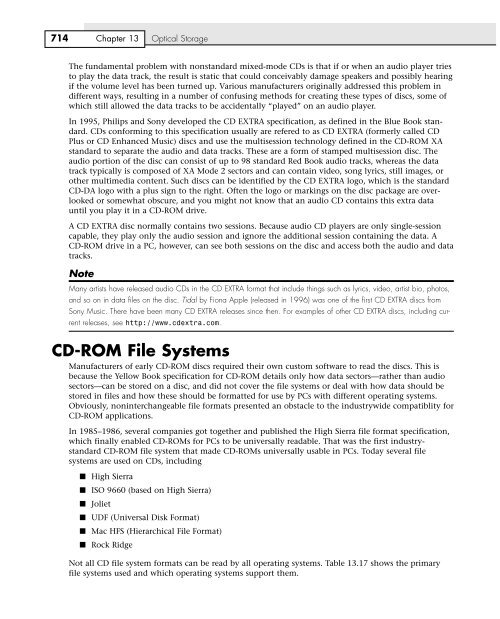Create successful ePaper yourself
Turn your PDF publications into a flip-book with our unique Google optimized e-Paper software.
714 Chapter <strong>13</strong> Optical Storage<br />
The fundamental problem with nonstandard mixed-mode CDs is that if or when an audio player tries<br />
to play the data track, the result is static that could conceivably damage speakers and possibly hearing<br />
if the volume level has been turned up. Various manufacturers originally addressed this problem in<br />
different ways, resulting in a number of confusing methods for creating these types of discs, some of<br />
which still allowed the data tracks to be accidentally “played” on an audio player.<br />
In 1995, Philips and Sony developed the CD EXTRA specification, as defined in the Blue Book standard.<br />
CDs conforming to this specification usually are refered to as CD EXTRA (formerly called CD<br />
Plus or CD Enhanced Music) discs and use the multisession technology defined in the CD-ROM XA<br />
standard to separate the audio and data tracks. These are a form of stamped multisession disc. The<br />
audio portion of the disc can consist of up to 98 standard Red Book audio tracks, whereas the data<br />
track typically is composed of XA Mode 2 sectors and can contain video, song lyrics, still images, or<br />
other multimedia content. Such discs can be identified by the CD EXTRA logo, which is the standard<br />
CD-DA logo with a plus sign to the right. Often the logo or markings on the disc package are overlooked<br />
or somewhat obscure, and you might not know that an audio CD contains this extra data<br />
until you play it in a CD-ROM drive.<br />
A CD EXTRA disc normally contains two sessions. Because audio CD players are only single-session<br />
capable, they play only the audio session and ignore the additional session containing the data. A<br />
CD-ROM drive in a PC, however, can see both sessions on the disc and access both the audio and data<br />
tracks.<br />
Note<br />
Many artists have released audio CDs in the CD EXTRA format that include things such as lyrics, video, artist bio, photos,<br />
and so on in data files on the disc. Tidal by Fiona Apple (released in 1996) was one of the first CD EXTRA discs from<br />
Sony Music. There have been many CD EXTRA releases since then. For examples of other CD EXTRA discs, including current<br />
releases, see http://www.cdextra.com.<br />
CD-ROM File Systems<br />
Manufacturers of early CD-ROM discs required their own custom software to read the discs. This is<br />
because the Yellow Book specification for CD-ROM details only how data sectors—rather than audio<br />
sectors—can be stored on a disc, and did not cover the file systems or deal with how data should be<br />
stored in files and how these should be formatted for use by PCs with different operating systems.<br />
Obviously, noninterchangeable file formats presented an obstacle to the industrywide compatiblity for<br />
CD-ROM applications.<br />
In 1985–1986, several companies got together and published the High Sierra file format specification,<br />
which finally enabled CD-ROMs for PCs to be universally readable. That was the first industrystandard<br />
CD-ROM file system that made CD-ROMs universally usable in PCs. Today several file<br />
systems are used on CDs, including<br />
■ High Sierra<br />
■ ISO 9660 (based on High Sierra)<br />
■ Joliet<br />
■ UDF (Universal Disk Format)<br />
■ Mac HFS (Hierarchical File Format)<br />
■ Rock Ridge<br />
Not all CD file system formats can be read by all operating systems. Table <strong>13</strong>.17 shows the primary<br />
file systems used and which operating systems support them.
















